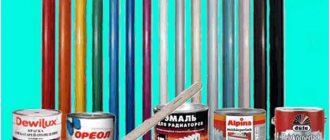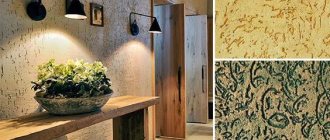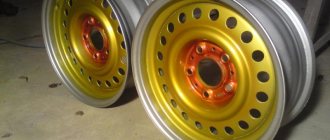The process of painting pipes must take into account the specificity of the item - coolant circulates through the main line. What tools do you need to use to apply it? Under what conditions should painting be carried out? The answers to all these questions are in our article. By painting pipes, several problems are solved at once:
- pipes delivering coolant inside and removing coolant from radiators are protected from corrosion;
- the heating system takes on an attractive appearance that matches the interior design.
Painting pipes in an apartment yourself - quickly and easily
It is impossible to imagine modern residential buildings and industrial structures without all kinds of communications: water pipes, gas pipelines, cables, and so on. Currently, many pipelines (for example, cold and hot water supply) are made of plastic. However, metal pipes continue to be used. To increase service life and improve appearance, these pipelines need to be painted.
As a rule, the reasons for deciding to paint pipes are:
- Unsatisfactory condition of the pipe surface.
- Corrosion protection.
- Improving the interior of the room.
What can fence posts be made from?
Wooden supports
Made from logs and beams. The logs are pre-cleaned of knots and bark. To increase service life, wood must be impregnated. The part of the pillar that will be below ground level is coated with bitumen mastic (2 times with an interval of 24 hours) and wrapped with roofing felt. The ground part is impregnated with an antiseptic and painted or coated with a special varnish AVIS Timbercoat.
They are most often used in the construction of chain-link fences and for wooden fences.
Advantages:
- relatively low cost;
- ease of installation.
Flaws:
short service life: 5-10 years (for light fences).
Wooden supports
Metal supports
Fence posts are made from profile pipes (square, round, rectangular cross-section), rolled profiles (hot-rolled angle, channel).
The pipes may be steel. They should be protected against corrosion (primed or painted). Galvanized pipes do not require additional corrosion protection, but are more expensive.
Profiles, like steel pipes, are cheaper, but are inferior to galvanized pipes in terms of corrosion resistance and need protection.
Used for the construction of fences from chain-link mesh, corrugated sheets, expanded metal sheets, forged metal sections, plastic sections, and wooden picket fences.
Advantages:
- durable;
- reliable;
- functional;
- simple and quick installation;
- universal;
- You can use used materials.
Flaws:
- steel poles need anti-corrosion protection;
- relatively expensive (except for used products).
Metal supports
Reinforced concrete supports
Concrete fence posts are reinforced with reinforcement during manufacturing, because concrete only works in compression, while reinforcement works in tension. Together they can support heavy loads and are called reinforced concrete. Frost-resistant and moisture-resistant additives are used in their production.
You can buy reinforced concrete pillars or make them yourself. Factory-made supports are of higher quality and cost more than those made at home.
They are used when installing fences made of concrete panels, chain-link mesh, corrugated sheets, and wooden fences.
Due to the fact that the posts can withstand heavy loads, they can be used for fences made of any materials, the main thing is to think about the fastening.
Advantages:
- a wide choice of appearance: from the simplest ordinary pillar to a variety of design solutions;
- durable;
- durable;
- installation of medium complexity;
- You can make pillars with your own hands.
Flaws:
- heavy weight;
- relatively high cost of finished products.
Reinforced concrete supports
Supports made of asbestos-cement pipes
When used as fence posts, asbestos-cement pipes are filled with concrete (the internal cavity) to make the post stronger and to protect it from water, which can freeze in winter and damage the integrity of the pipe. A cap is placed on top of the pipe.
They do not have embedded parts or other auxiliary devices for fastening fence elements.
Used as posts for wooden fences (fastening with clamps, self-tapping screws), tension fences made of chain-link mesh (fastening with wire), plastic fencing.
Advantages:
- do not corrode, rot, and do not require additional protective measures;
- simple installation;
- relatively low cost.
Flaws:
- fragile;
- Suitable mainly for fences made of lightweight materials.
Fencing with supports made of asbestos-cement pipes
Plastic pipe supports
Plastic pipes are made from polycarbonate. They are used for installing plastic fences; they can also be used for wooden fences and chain-link fences.
Advantages:
- do not corrode or rot;
- do not lose their appearance when exposed to the sun;
- wash;
- simple installation;
- do not require maintenance during operation;
- relatively low price;
- durable;
- can be painted in any color (add a plasticizer to the paint);
- beautiful appearance.
Flaws:
Suitable for light fences only.
Fencing with supports made of plastic pipes
Brick supports
Brick pillars are installed on the foundation. Another pillar (either reinforcement or corner) is mounted inside, which is concreted into the foundation.
Brick supports are suitable for fences made of any materials. They are often used for fences made of corrugated board and brick.
Advantages:
- reliable, can withstand any weight;
- beautiful view;
- capital durable structure.
Flaws:
- complexity of construction;
- price.
Reasons for painting pipes
We all know that paint, applied even in a small layer, serves as protection for water and heating pipes. It prevents their corrosion. In addition, using paint of a certain color, you can complement the interior or simply successfully fit pipes and a radiator into it. And even if the radiator you bought already has a suitable color and a protective layer against corrosion, the same cannot be said about the pipes.
It doesn't matter what material they are made of. It is better to treat plastic and metal pipes with paint. There are a number of reasons why this measure must be carried out without fail:
- The old paint layer has become peeling, cracked, or otherwise damaged.
- You have just installed pipes that do not yet have corrosion protection.
- The need to create completeness in the interior, decorating heating elements.
- A planned measure to prevent damage to the heating system.
Regulatory documentation for identification painting of pipelines
In each industry, there are a number of regulatory documents regulating the issues of identification painting of pipelines, however, all these documents either refer to or repeat the requirements of the main standard for identifying pipelines in the Russian Federation - GOST 14202.
This unification of markings makes it possible to unambiguously determine the contents of a pipeline at any facility - from a small modular boiler house to a nuclear power plant and an oil refinery.
Exceptions to which the requirements of GOST 14202 do not apply are pipelines with medical gases, ship and aviation pipelines.
Sequence of work
Painting pipes begins with preliminary preparation, which includes three main stages. The first - surface preparation - includes removing the old coating and cleaning. The second is priming and the third stage is painting. It is very important that the pipes are dry before starting work. Otherwise, the result of the work will not last long and everything will have to be repeated again.
At the first stage, the main thing is to remove all the old coating. This will make it possible to clean the places where rust has formed. It is better to use a wire brush with stiff bristles. As an addition, a solvent can be taken. Before starting work, you need to take safety measures, put on a mask so as not to breathe dust, and protect your hands with mittens or gloves. To make it easier to remove old paint, you can heat it up using a hair dryer. Then start cleaning. All work performed will allow the metal to last longer.
Painting heating pipes
The cleaned surface must be degreased using special compounds. This will remove any remaining dirt and dust.
The next stage of preparation is primer. This will help protect the pipes from rust, extend their service life, and the paint will adhere more smoothly. It is applied in a thin layer. Experts advise using an alkyd-based primer; it perfectly protects metal and steel surfaces. Everything must dry thoroughly before work continues.
The primer has dried, you can begin the final stage - painting. To do this, you will need a small brush with soft bristles. It is better to apply the paint in two layers, this will make it possible to obtain the most even coating. The second layer is applied after the first has dried. If the paint is very thick, it will lay down in a thick layer, take a very long time to dry, and untidy streaks may appear on it. It's better to dilute it. You can use a spray gun. This will significantly speed up the process, and the paint will lay down in an even layer, without drips.
You should pay attention to the protection of walls and floors before starting work. The best option would be a piece of polyethylene secured with masking tape.
Preparation
The choice of painting method and type of paint depends on the material from which the pipes are made, as well as on their operating conditions. For example, communications located in the open air should be painted with red lead, due to which a mask of iron oxide and lead is formed on the surface. This mask is able to protect pipelines from the destructive effects of the environment.
The following products are usually used for painting pipelines:
- alkyd enamel;
- water-dispersion paint;
- acrylic enamel;
- Oil paint.
Acrylic enamel is resistant to high temperatures (up to 1000 degrees). It is also resistant to significant temperature changes. The advantages of water-dispersion paint are fast drying speed, high quality of adhesion to the surface and environmental friendliness. Pipes painted with water-dispersion paint can be used for many years. Such paint, in turn, is divided into two types: for cold and hot surfaces. That is, painting heating pipes will require the use of paint intended for hot surfaces.
Acrylic enamel has the ability to retain color for quite a long time (it is resistant to ultraviolet rays). In addition, this paint makes the surface glossy. Before using this type of paint, the surface must be treated with a primer. And finally, oil paint is suitable for processing almost all types of pipes. However, over time, the original color is lost.
For painting we will need the following:
- brush;
- dye;
- sandpaper;
- gloves;
- rag;
- primer;
- cuvette;
- ladder (when working at height).
Before you start painting, it is advisable to clean the surface of the pipes from old paint. After this, you need to thoroughly clean the surface with sandpaper. There should be no rust. All cracks and irregularities must be repaired using putty. Before painting plastic pipes, they need to be washed with warm water. After this, you need to give them time to dry.
The old paint does not need to be removed if the surface of the pipe has no defects: damage, bulges, cracks. Otherwise, it is better to remove the old layer of paint.
Now we determine how much paint is needed. Here are some recommendations on this matter:
- For hard to reach places you will need more paint.
- The first coat requires more paint than the second.
- A smooth surface will require less paint than a rough surface of the same area.
Rules for calculating the amount of paint
There are no uniform standards for calculating the amount of paint for coating pipes, since all painting materials have different properties (viscosity, density, list of components, etc.). But the approximate paint consumption per 1 sq. The surface meter is indicated on the container in which it is sold. Please note that 2 layers will be required. Therefore, to correctly calculate the required amount of paint, it is necessary to determine the surface area of the pipe.
When painting pipes, you need to take into account their type, purpose, material of manufacture, etc. And the paint itself must correspond to the parameters of the utility service being processed.
Features of application
The choice of color for painting depends on preference. Some cover products to match the walls, while others make the mounted pipes more noticeable in the interior.
Paint selection
So, you can paint the pipes green, and then decorate them with artificial grape leaves. The result will be a grape vine that will look good in the kitchen if the entire room is designed accordingly.
Dyes for metal
Conventional metal paint has the following advantages:
- Low cost
- Availability, sold in all hardware stores.
- Easy to use because there is no need to prepare a base. The composition is simply applied and dries on the surface.
Often painting with conventional paints for metal substrates is carried out using a spray gun. The device allows you to evenly distribute the composition over the surface.
Such substances have a thick consistency. Therefore, the process must be performed as quickly as possible and additionally use a solvent to dilute the coloring composition.
Regular dyes
This method of painting polypropylene pipes has many negative aspects. The main disadvantage is the instability of coloring compositions when applied to heating pipelines.
Using regular wall paint can reduce the visibility of pipes in the interior. After all, the system will have the same color as the wall structures.
Acrylic and polyurethane
Acrylic and polyurethane dyes belong to the group of “soft” compounds used at home for painting polypropylene pipelines. One of the components of such substances is a solvent. However, it does not cause any harm to the plastic.
Acrylic paintsTherefore, acrylic and polyurethane substances should be used on pipes with the thickest walls possible.
Special attention must be paid to this point if a heating system is created from pipe products
Special dyes
The main disadvantage of special paints for polypropylene pipelines is the high price. However, such compositions are no more durable than other commonly used materials for painting plastic engineering systems.
Aerosol paint
The drying time of special mixtures depends on the period of the year. If work is carried out on hot days in the summer, the painted pipeline will take longer to dry than in moderately cool weather.
Painting with primer
This method of painting polypropylene surfaces differs from other methods, since it involves preliminary priming of the pipes with the same composition. Preparation of pipelines is carried out with substances released in the form of aerosols. Primers are designed to protect treated surfaces.
The substances also help to increase the adhesion of coloring compounds. Primers for polypropylene pipes can be purchased at markets and auto parts stores. After all, such substances are used when painting vehicle bodies.
Painting nuances
Today, modern materials are used in the construction of houses and laying communications: plastic, stainless alloys, non-ferrous metals. And the communications themselves - sewerage and water supply - remain mostly hidden.
Heated towel rails are made of stainless steel or have a galvanic coating. But in old houses there are still pipes made of ferrous metal (cast iron and steel).
They are susceptible to corrosion, do not look aesthetically pleasing and require increased attention, including proper regular painting.
Purpose of painting
It is worth noting that the requirement for painting pipes is by no means a recommendation. Moreover, failure to comply with or comply with the requirements of SNiP in the appropriate manner is punishable by law.
This does not happen because someone wanted to transform the world around them, painting it with fresh new colors. After all, like any other technological facilities, pipelines need to be maintained and repaired, and accidents can occur with them. And the Ministry of Emergency Situations, rescue services and other organizations of this profile must have information with what substances they will have to come into contact with, on the basis of which they will be able to develop a set of measures to eliminate or localize the danger.
It would be useful to recall that pipelines transport not only tap water, heating substrates and sewage effluents. Modern production, and in particular the chemical industry, has long used substances such as:
- explosive and flammable gases and liquids of various origins;
- toxic gases and liquids;
- saturated steam;
- superheated steam;
- substances with high blood pressure;
- non-flammable liquids and gases;
- alkalis of various compositions;
- acids, including concentrated and fuming ones;
- hazardous organic compounds;
- air vacuum;
- other particularly important or dangerous substances.
By the color of the pipeline you can understand how dangerous its working environment is and how to work with it in the event of an accident
Painting industrial pipes is relevant because not knowing what substance you will have to deal with in the event of an accident at a large production facility can lead to catastrophic consequences not only on a regional, but also on a national scale.
Which composition to choose
In order to paint the outline, you need to choose a paint for heating pipes that is resistant to heat. And the point is not that it will leak, but that it may change color or crack. Before painting heating pipes in an apartment, you should also take into account such an important characteristic as smell.
There are mainly two types of paints used for heating pipes:
- alkyd paint for metal heating pipes - based on organic solvent;
- acrylic enamel - odorless paint for heating pipes, the binder is an acrylic polymer emulsified in an aqueous environment.
Oil paint for heating pipes has not been used for a long time, as it has a strong smell, takes a long time to dry, and costs the same. It has been replaced by new, more convenient formulations.
The peculiarity of acrylic enamels is that when heated they do not change shade at all. This is especially noticeable when painting heating pipes white. Despite the fact that there are many articles on the Internet about how well alkyd enamels serve without changing color, you can hear the opposite from professionals. Before painting a heating pipe, keep in mind that when heated, alkyd enamel changes its color; in the case of white paint, it turns yellow. With other colors this effect is almost invisible, so don't focus on it so much.
Brush and paint in skillful hands
Based on the fact that alkyd paint for heating pipes contains a solvent, the smell is correspondingly strong even for products labeled GF (for interior work). There are also paints marked PF, which are used for outdoor work. They can also be used when painting indoor heating pipes. Alkyd enamel dries within a day and stops being smeared after 4-6 hours, depending on the temperature in the room.
Acrylic paints dry much faster than alkyd paints, about an hour. At the same time, they do not stink; of course, there is a specific smell, but it is not pungent and evaporates very quickly. Decide for yourself what is the best way to paint heating pipes; the author’s recommendation is acrylic enamel.
Please note that the acrylic paint must contain a corrosion inhibitor, which will prevent the pipes from rusting. If it is not there, then the paint and the surface to be painted must be separated by a layer of primer for heating pipes.
It is recommended to paint heating pipes with your own hands when the circuit is cold, so if it is hot to make repairs during the heating season, it is better to postpone it until a more convenient time:
- it will be possible to open all the windows so that the smell disappears faster;
- On a hot circuit, the paint hardens very quickly, making it impossible to distribute it evenly. This is especially true for acrylic enamel.
Rusting of metals
Metal structures are subject to rust, and these processes occur in stages, chemical reactions flow into one another. Prerequisites and conditions for the start of the rusting process: the metal contains certain impurities (carbon and sulfur), oxygen and water have access to the surface. Carbon and sulfur, which are included in the composition of steels as additives, act as corrosion enhancers - the layer of formed rust is destroyed, a new layer of metal is exposed, and the process continues.
If there is an acidic environment and/or salts are present, the rusting process will accelerate even more. Acidity is increased by substances contained in atmospheric water - sulfurous and carbonate acid. Water causes corrosion of unprotected metal surfaces, regardless of their state of aggregation - in the form of vapor, liquid phase or ice.
When metals rust, the resulting layer of rust does not protect the surface, as in the case of passivation (creating a protective film on metals) and cannot prevent subsequent corrosion. Rust has a loose and hygroscopic structure, instantly accumulates moisture from the air and retains it. As a consequence, if rusting has begun, the growth of rusty layers accelerates oxidative processes for two reasons: the relative thickness of the metal decreases and the duration of contact with moisture and oxygen increases.
In ordinary cases, painting metals over a layer of rust makes no sense. Moisture and air have accumulated in the pores of the loose structure, which are sufficient to continue the processes of destruction of metals under the paint layer. In addition, rust cannot be compared to steel in terms of density; it is a weak and loose layer, and as a result, a stress zone forms under the paint layer - expansion of the corroded metal. As a result, the paint layer is covered with through craquelure cracks, and the paint quickly breaks down and flies off the surface even if the paint coating is locally damaged.
Painting plastic pipes ↑
There is no need to paint plastic pipes; they are not afraid of external influences, except perhaps ultraviolet radiation. The application of a coating can be justified by aesthetic considerations, because standard colors (white, gray, less often beige and green) will not always satisfy everyone in open areas. Manufacturers offer, as for metal, special primers for plastic. However, in all honesty, there is little sense in them and you can completely do without it. Polymer products should be painted with non-aggressive compounds, exclude brands NTs, ML and those whose solvents are acetone, 646 and the like.
To watch online, click on the video ⤵
Painting the inside of a pipe is easy! Device for interior painting of pipes ASpro. More details
Painting pipes from the inside Read more
SUPER METHOD Cleaning profiled steel pipes and preparing for painting More details
fantastic ideas for metal, Read more
Painting of profile pipe 40x20 Read more
Top 5 ways to remove rust. We test simple and inexpensive methods in garage conditions. More details
Internal painting of pipes Read more
How to Paint the Inner Surface of a Pipe Read More
Painting cast iron heating radiators. More details
How to get rid of Rust and Corrosion FOREVER | How to save metal Read more
How to quickly paint pipes Read more
HOW TO WELD A PROFILE PIPE AND NOT BURN IT! More details
How to EASILY remove rust at home. More details
AMAZING RUST REMEDY, how to remove rust in 2 hours! More details
DIY bathtub restoration, liquid acrylic. More details
Rust - how to remove and how to paint? More details
Repair / REMOVING OLD PAINT FROM A CAST IRON BATTERY / Removing old paint from a cast iron battery Read more
How to make a welding seam invisible? Joining of profile pipe. More details
How to choose paint for batteries? How to paint a battery or radiators? More details
Coloring process and recommendations
Heating systems in the bathroom need painting once every 2-4 years. During repair work, painting of pipes is carried out at the last stage. The paint can be applied with a brush, spray or roller. Batteries can be processed over old layers, but only if they are undamaged and smooth. Even if there are small cracks or bulges, you will have to tear off all the layers and paint the pipes again.
- Before painting, apply a primer, and it is important that the batteries are not wet. To do this, they must be wiped with a dry cloth.
- After the primer layer has completely dried, you can begin painting. The pipes need to be coated in 1 layer, it should be minimal. If the paint shows through, you will need to treat the surface twice.
- The product for painting pipes in the bathroom is applied with a spray gun or brush. Sometimes a roller is used for this process, but this tool is inconvenient to work in hard-to-reach places. Very often you have to use a special radiator brush, which can fit into any thin openings and paint the hidden parts of the pipes.
- It is better to paint heating radiators in the bathroom in the spring and summer, when the pipes are cold. Painting them in winter is also allowed, but you can get an uneven layer that will look sloppy.
- It is recommended to use only heat-resistant paints for painting, which provide a durable layer that does not emit harmful substances during heating.
- To get more warmth, you can use dark-colored dyes.
It is very simple to calculate how much paint is needed for radiators in the bathroom. Usually, the packages immediately indicate the amount of substance that is needed to treat 1 m². If there is no such designation, then you can use the formula: the length of the pipes must be multiplied by their diameter and by 3.14.
In addition, it should be taken into account that the paint is applied in 2 layers, so the resulting number is doubled. This way you get the required amount of paint for the pipes in the bathroom. If you follow all the rules for painting batteries in the bathroom, you can do it quickly and efficiently.
How to choose the right coating for radiators
Any specialist involved in the repair of pipes and radiators, when asked what paint is best to paint heating radiators, will answer:
- The paint coating must be thin and with maximum thermal conductivity of the paint layer in order to ensure good heat transfer to the room air;
- The paint must provide protection to the metal surface;
- The coating must withstand heating temperatures of up to 150°C for high-pressure radiators and 120-130°C for conventional steel or cast iron batteries.
For your information! Paint for cast iron radiators, in addition to all the above conditions, must have high fluidity and low viscosity.
Even after priming, the cast iron surface remains quite rough and porous, so aerosol molds are the best choice for cast iron. The radiator is painted in several passes, each layer must be thoroughly dried and any stains removed. As a rule, heat-resistant spray paint for radiators has a very low odor, but it is necessary to paint installed radiators only with the windows open, in dry, warm weather.
For conventional steel and aluminum heating radiators, the use of aerosols allows you to apply a thin layer to the most hidden places where it is difficult to reach with a brush or roller. In addition, a thin layer of enamel dries 2-3 times faster, which means that even if there is a slight odor, it will disappear in half an hour. The smell from a thick layer of enamel on an organic solvent will stay on the radiator for 5-6 hours, for oil or pentaphthalic paint - for several days.
Heat resistance and volatility of paint for heating appliances
First of all, it should be noted that odorless paint for heating radiators does not exist in nature. Any enamel has a slight but pronounced odor. Even paints for heating appliances, interior wall decoration based on acrylic polymers, or simply water-based brands also have an odor.
Ask a store clerk or building materials showroom for odorless radiator paint, and he will give you a whole list of heat-resistant enamels with the word “odorless” on the label. Actually this is not true. If you take the most seemingly safe water-based paint and paint a heating radiator at a temperature of 30-45°C, the smell will be quite unpleasant.
Imported, for example, Polish, Czech or German paints for interior work and heating radiators may have virtually no odor or have a light pleasant aroma, for example, of fresh ice cream or sawn wood. But this does not mean that such odorless radiator paint is absolutely safe and cannot affect your well-being.
Production technology makes it possible to skillfully mask the real smell of paint, therefore, imported paints and varnishes use a special index of volatile organic compounds, or in the abbreviated version - VOC. Instead of a vague concept of odor, VOC precisely defines the maximum content of volatile organic compounds that will have to be inhaled when painting a heating radiator. Even for safe, and practically odorless, acrylic enamel for heating elements, the standard allows no more than 130 g of organic volatile substances per liter of material.
The easiest way is to determine the heat resistance of the paint and varnish material. The label of a can of enamel for heating systems always indicates the maximum temperature of the radiator at which the coating can be applied and the upper limit for heating the battery. For central heating systems, the coolant temperature rarely exceeds 100°C, but in private homes, part of the pipes that drain hot water from the boiler heat exchanger can heat up to 120-130°C.
PIPT-01:
| Description | vendor code |
| PIPT-01 for painting the internal surfaces of pipes (Ø 50 – 300 mm) gun, 6 m air hose, 6 m material hose ¼ BSP x ¼, spray nozzle 0.26″, in a box | |
| 15 m air control hose (optional) | |
| Material hose 15m, 1/4″ NPTS x 1/4″ NPTS (additional order) | |
| Spray nozzle 0.18″ (additional order) | |
| Spray nozzle 0.21″ (additional order) | |
| Spray nozzle 0.26″ (standard supplied with PIPT-01) | |
| Spray nozzle 0.31″ (additional order) |
Any airless spraying unit with a pneumatic motor or electric drive can be used as a painting machine for internal pipe painting.
You can also use a gas-powered paint sprayer or just a spray paint tank.
It is only important to comply with the performance requirements of the painting apparatus.
The productivity of the painting machine for working with the PIPT-01 internal pipe painting device must be at least 2 l/min.
The movement of the PIPT-01 internal pipe painting device during the pipe painting process is carried out by the operator manually by the painting hose in the direction of the operator at a constant speed.
What to remember
Let us note, dear reader, the main rules that must be observed when painting a fire pipeline.
- All structural elements of fire extinguishing systems always have a red tint.
- The color tone of a fire pipe depends on the type of substance.
- When painting, use GOST R 12.4.026, SP 5.13130.2009, VSN 25-09.67-85.
- Depending on the hazard class of the substance contained, the steamer is marked with colored rings and warning symbols.
- Plastic products are also painted according to GOST 14202-69.
With this we say goodbye to you, dear readers. Use the tips above to avoid being targeted by fire inspectors.
See you in the next article!










